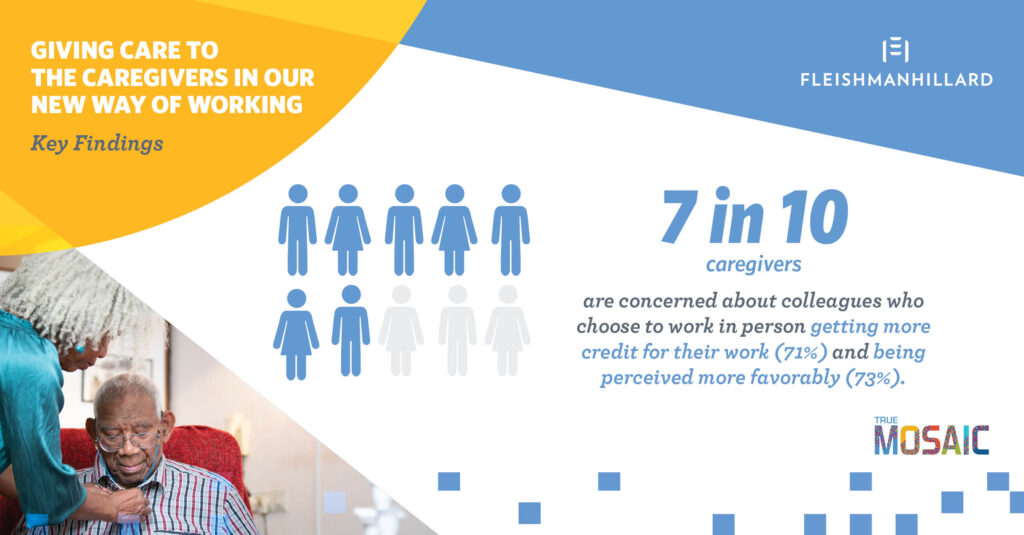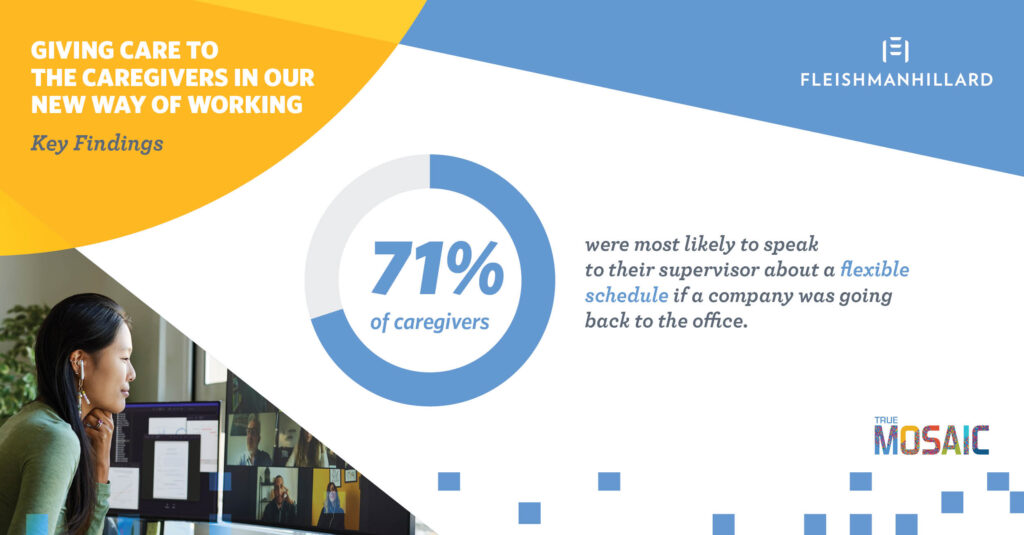Returning to Work: Supporting Caregivers While Centering Equity in the Workplace
From the True MOSAIC “Giving Care to the Caregivers” thought leadership series
With more than two years of data to support a path forward as leaders make plans for a return to office, many workers with caregiving responsibilities are finding a safe space in hybrid models. However, while hybrid models allow for potential worker flexibility, it also has the potential of creating inequitable workplaces as those who work in-person may have more contact with managers and executives, while those who stay home fall out of sight and out of mind.

Caregivers have a unique set of needs that should be considered when companies return to the workplace in any form. In True MOSAIC’s latest study, “Giving Care to the Caregivers”, we found:
- Caregivers are concerned about proximity bias and those concerns should be addressed by workplace managers.
- Specifically, 7 in 10 caregivers are concerned about colleagues who choose to work in person getting more credit for their work (71%) and being perceived more favorably (73%).
- When it comes to the benefits of a hybrid or remote setting, parents were most likely to report more time with family as a benefit of working remotely.
Although they take the lead on increased work hours (64%), 90% of caregivers who work remotely or in hybrid arrangements agree that freedom from commuting has allowed for more personal time. This personal time can be used to take care of home responsibilities, including looking after others.
The Gift (and Responsibility) of Flexibility
Companies’ return-to-work plans will have a direct impact on people’s day-to-day lives. At a time when organizations are struggling to find and retain talent, they risk losing some of their most valuable contributors – caregivers.
In the study, we found that mandates to come back to the office full time may lead to tension among employers and employees. If presented with an ultimatum, many employees surveyed would either comply or speak to their supervisor about flexible work arrangements. Nearly a quarter (24%) of employees would look for a new job. The data is striking and is consistent with labor trends that have seen many employees leaving their jobs in recent times.

Additionally, the cost to replace employees who resign from the company can be expensive. In fact, the U.S. Bureau of Labor Statistics estimates it costs $160,000 to replace a position that earns $80,000 per year. At a time when more employees expect flexibility, it simply makes sense to find ways to address the needs of employees.
For caregivers, especially, flexibility is key. But what does flexibility look like in practice? For some, it means they have the option to choose hours that meets the demands of caretaking, meetings, and other home and work responsibilities. For others, it means the option to work four-day weeks or part time. However, an individual chooses to define it, the definition of flexibility is determined by the employee — not the employer. The data shows that caregivers are split on how they would like to work: 39% prefer in-person work settings while 40% prefer hybrid working arrangements.
Like anything, there’s a responsibility that comes with flexibility. Whether you are an employee or employer, trust is to be earned for flexibility in hybrid models to work. While leaders should look to extend flexibility to employees, employees need to perform their duties and meet expectations in order to earn the trust of their employer. This is also true for colleagues working together on the same team where interpersonal communication and teamwork will help to ensure that trust is instilled in the day-to-day work.
Our study shows that generally, hybrid work is the employee preference and that among respondents who prefer hybrid work, the ideal work schedule consists of two to three days in the workplace per week. Across demographic groups, employees would prefer to ease into returning to the workplace with flexibility as a guiding principle.
While the preferences lean slightly toward hybrid work, it’s important to remember that caregivers are not a monolith. Individual preferences should be considered as employers seek to hire and retain top talent. In the end, if employees feel their job fits their life choices, they will be able to bring their whole selves to work and fully engage in the job long term.
###
The research for the True MOSAIC “Giving Care to the Caregivers” thought leadership series was conducted by FleishmanHillard’s TRUE Global Intelligence, the agency’s in-house research practice. Research for the report is based on a total of 2,076 respondents including a U.S. nationally representative sample (based on gender, age, region) of n=1,056, and an oversample of respondents who self-identified as Disabled (n=278), AAPI (n=250), Hispanic (n=260), Black (n=280), Caregivers (n=272), and Parents (n=274). The survey was conducted between March 15-29, 2022.
This blog post is part of a series focused on caregivers and our new ways of working, exploring what leaders should consider in their return to office plans. The next blog in the series will address how hybrid work models bring work-life balance to caregivers.
